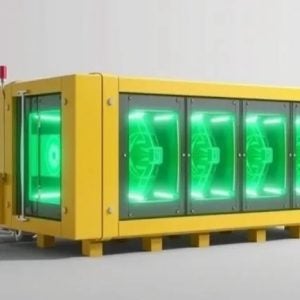
UK-based start-up Core Power CEO Mikal Bøe told a press conference that the company is expecting to see its first orders for vessels equipped with nuclear reactors before 2030. This includes both floating NPPs (FNPPs) and nuclear-powered ships.
“The formation of the first order book starts in 2028-29,” Bøe told Ship & Bunker at the event. “Our aim is to build a $10bn order book by 2030, and the first deliveries would then be in 2030-35 — we’re not quite sure, but I’d say probably in the latter end of that bucket.”
He added that the initial orderbook would probably be for FNPPs. “It’s kind of a low-hanging fruit, a very big market, and it’s easier to deliver from a regulatory point of view. “But I would expect to see the first ship orders coming through not too late after that.”
A nuclear-powered ship would have a number of advantages including zero carbon emissions, while the excess energy produced by the reactor would enable ship to travel faster with the possibility of sending power back to the land-based grid while at berth. However, the high up-front capital costs for a ship of this type, would be around $700m.
Core Power plans to lobby for updates to standards from the the International Maritime Organisation (IMO) and the Inernational Atomic Energy Agency (IAEA) to provide a regulatory framework for nuclear-powered shipping. Bøe expects the IMO to modernise and revise its current code for nuclear merchant ships by 2028. “We think the IAEA is pretty much ready to do this. “They’re doing it now, and I think that they’ll be ready before the IMO,” he noted. “And then, of course, you really need to work separately with the insurance industry to make sure that they have the right liability regime in place.”
Bøe told the meeting that the molten salt reactor (MSR) design that Core Power is working on, using heated and liquefied chloride salts, can solve a number of issues for the maritime sector.
MSR technologies were first tested in the US as a nuclear option for aircraft in the 1950s. A six-year experiment at the Oak Ridge National Laboratory then tested the technology before being cancelled. Bøe stressed that this was using old technology and designs and the new designs would not face a similar fate.
Bøe said the first vessel using MSR technology could be launched as early as the mid-2030s, with the company about to build a micro-reactor to test the design, at Idaho National Laboratory (INL) in the US, before then producing a commercial prototype. In August 2022, Core Power, MIT Energy Initiative and INL were awarded research funding by DOE’s Nuclear Energy University Program, a three-year study into the development of offshore floating nuclear power generation in the USA.
Core Power is also a participant with US-based TerraPower and power utility Southern Co, in the Molten Chloride Reactor Experiment (MCRE). In 2021, Southern Company DOE signed an agreement to design, construct and operate the MCRE as a proof-of-concept critical fast-spectrum salt reactor. MCRE aims to be which the world’s first fast-spectrum salt reactor to achieve criticality at INL, Collaborators in the MCRE project are Terrapower, INL, Orano (USA) Federal Services, Electric Power Research Institute, and 3M Company.
The project is supported through the DOE’s Advanced Reactor Demonstration Program (ARDP) under a five-year, $170m cost-shared funding agreement. It will provide crucial operational data to support the future development of TerraPower’s Molten Chloride Fast Reactor (MCFR), informing the design, licensing and operation of a demonstration reactor.
Bøe said $2.5bn would be spent on development before a commercial ship is even ordered, much of the financing coming from the US government funds. That is in addition to $150m Washington has already invested, while Core Power shareholders, Wan Hai, Express Container Lines, Terrapower and Hyundai Heavy Industries have all invested in the MSR development. And a new funding round is expected in 2025-26.
Core Power was formed in 2018 “to bridge that gap and create an organisation that would pave the way for development and successful deployment of advanced reactor technologies for the maritime industries”. In 2023, the company attracted Japanese investment for its FNPP project. Some 13 companies, including Onomichi Dockyard and Imabari Shipbuilding, had invested about $80m in project, according to Nikkei Asia. Although Core released no statement on the development, it reproduced the Nikkei article on its website.
According to Nikkei, Core Power said at that time that it planned launch a demonstration vessel in 2026 and commercialise it between 2030 and 2032. The company aimed to build a track record overseas, then expand in Japan. It estimated that the demonstration vessel would require approximately JPY50bn ($361m), and Core Power and its partner companies would share the cost. The investment by Japanese companies would also be used to fund development, Nikkei said.
In May, in his capacity as Vice Chair of the recently established Nuclear Energy Maritime Organisation (NEMO), Bøe addressed the IMO on behalf of the World Nuclear Transport Institute (WNTI) at the 108th session of the Maritime Safety Committee. He said NEMO will help WNTI spearhead the essential work to assist the IMO and the IAEA with the modernisation of the entire regulatory ecosystem for nuclear-powered ships and floating nuclear powerplants. “Our common aim is to have a fit-for-purpose ecosystem of rules and regulations established by 2030.” He added that NEMO will apply for consultative NGO status at the IMO in due course.






